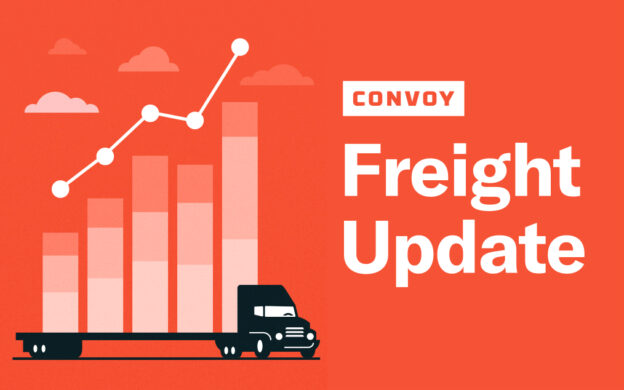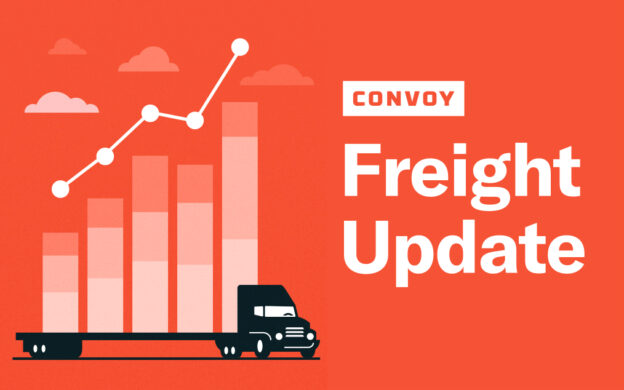Coronavirus and Freight: What are the long-term impacts?
Freight Research • Published on March 31, 2020
No one quite knows what the lasting impacts of the coronavirus pandemic will be for the freight industry. If past crises are any guide, moments of crisis tend to accelerate shifts that were already underway. But there are also points of continuity.
Today we’re sharing the third of our twice weekly video series featuring Ari Bixhorn, our Head of Shipper Marketing and Aaron Terrazas, our Director of Economic Research.
In this video, we discuss what lessons the freight industry can draw from American’s preferences for cars after the Oil Crisis of the early 1970s and their preferences for housing after the housing crash of 2008. We also look ahead toward two possible long-term shifts for the freight industry.
Subscribe to Freight Economics Updates to get the latest developments delivered directly to your inbox.
Convoy provides shippers reliable, flexible, and instant capacity when they need it most. Learn more about shipping with Convoy today.
View our economic commentary disclaimer here.

You can read the a transcript of the conversation below:
Ari Bixhorn: Hey everyone. Welcome to Convoy’s ongoing analysis of the freight market during the COVID-19 crisis. We’re recording this video on the night of Monday, March 30th. I’m Ari Bixhorn from the Convoy team and joining me today is Aaron Terrazas, our Director of Economic Research. Aaron, welcome.
Aaron Terrazas: Hi Ari.
Ari Bixhorn: Aaron, things continue to evolve rapidly on a day-to-day basis, both for the American economy and for the freight industry. As a result, I think a lot of the focus and coverage has been on the immediate term impact of the situation. What do you think the longer-term impact is going to be?
Aaron Terrazas: Obviously we are in a state of extreme unknown and the reality is no one really knows what the long-term impact is going to be. We can try to look at some past historical experiences and see how those evolved, what people were thinking in the moment, how did things ultimately end up, and we can try to learn from those experiences. So something that comes to my mind for example is if you take the oil crash, or the oil price surge of the early 1970s that was an enormous shock to the American economy. In some ways, it prompted dramatic changes, in other ways, things continued largely the same.
So it did shift Americans’ auto purchases toward smaller, more fuel efficient vehicles. It gave a new opening for the Japanese and European automakers that specialize in those types of cars. At the same time, you think about the auto industry in the 1980s and 1990s and there was a surge of SUV and white truck demand. So the oil shots came in a moment. It kind of hit when environmental awareness was kind of on American’s consciousness after the 1960s and so it certainly did change things in the margin. But in other ways, things continued and a lot of consumer preferences did revert back to what they were beforehand.
So if you think about how this is likely to evolve, again, no one knows, but some things will continue, some things will be different.
Ari Bixhorn: A more recent crisis that comes to mind is the housing crash of 2008 that obviously led to the last recession. What were the lasting impacts of that?
Aaron Terrazas: The housing crash back in 2007, 2008 really prompted enormous intersection in the real estate industry. Were young adults who came of age during that period going to want to become homeowners or were they going to rent and become urban renters for a longer period. And if you look at how US real estate has played out over the past decades since that crash, certainly young adults did kind of rent for longer than the previous generations. But ultimately, many of them did kind of repeat the same patterns of prior generations as well. Home ownership rate did remain lower for a long time. But as now, for the past two or three years, it’s been back at its levels from the late 1990s pre-bumble levels.
Many of the young adults who delayed ownership delayed many other kinds of major life decisions. But once they started making those major life decisions, many of them did ultimately buy suburban homes in the same model of prior generations. So again, like the old crash of the 1970s, it’s a similar story, kind of some things just are on margins, but ultimately consumer preferences do change. Now, it’s not universally. You look at kind of the so-called depression babies of the 1930s and these have had lasting changes in consumer preferences. So it’s never kind of definitive, but the past two crises in the 1970s and 2000s shifts are on the margins, continuity in the long term.
Ari Bixhorn: And in both of those more recent scenarios, the housing crisis and the shift in the automotive industry, basically what we saw there was an acceleration of changes that were already underway. When it comes to the freight industry and what we’re currently facing, are there analogous trends that might accelerate?
Aaron Terrazas: The first one that comes to my mind is the diversification of supply chains. So you think about this new found awareness that many manufacturers, many companies have come to that concentrating their supply chains carries enormous risk. This is a change that was already underway pre-crisis. It really started to bubble up after the trade war. I recently saw a McKinsey survey that showed that the number of CEOs and business leaders who are thinking about diversifying their supply chains has increased pretty sharply if you look at December, just into March in the early days of this crisis.
So that’s I think something that’s going to continue, was already under way in many respects. There are other shifts that perhaps will be less durable. You think about the shift over the past three or four weeks in how and where Americans eat away from restaurants toward more at home groceries. Obviously, that has enormous implications for freight demand just because the way that restaurants get stalked up on their food and the types of trucks that deliver those, the types of service that deliver those are very different from the types of trucks and services that restock grocery stores. That shift over the past three weeks comes on the heels of a decade when restaurant spending has just been on a tear.
If you look at restaurant sales per capita over the past decade since the end of the financial crisis, they’ve increased at twice the rate of regular grocery store sales per capita. So much larger increase in restaurant spending than grocery spending. It’s hard to imagine that once Americans are able to go outside again and eat out, that this trend toward grocery spending will at least in total continue. So I imagine there will likely be some quite a bit of aversion there.
Ari Bixhorn: So sort of similar to what we’ve seen in the past, some of the trends that are already underway are likely to accelerate, while if we look at the changes that have sort of been in immediate reaction to the crisis, those may not be as long lived.
Aaron Terrazas: Yeah. No, that’s entirely true. Yep.
Ari Bixhorn: All right. Well Aaron, thank you as always for your time and your analysis. And everyone watching, thank you for tuning in. Aaron and I will continue to provide updates on the Coronavirus and the freight industry. Subscribe to our YouTube channel and the Convoy Blog to stay informed. We’ll see you next time.


